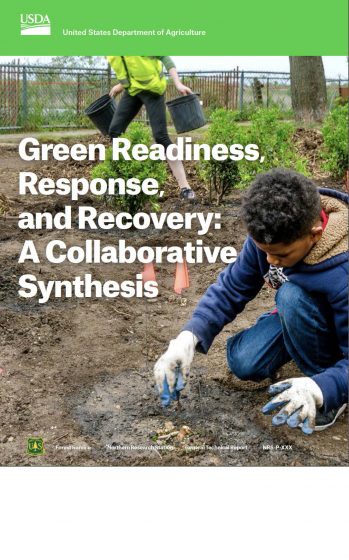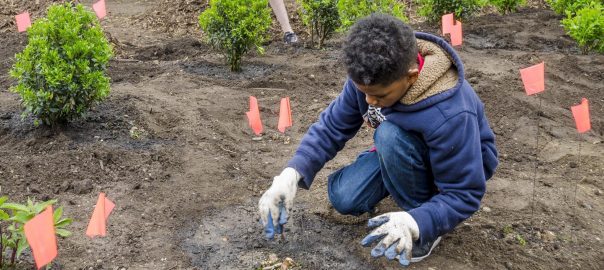 A collection of case studies, interviews, and personal reflections inspired by a national workshop, Green Readiness, Response, and Recovery: A Collaborative Synthesis includes lessons learned from a diverse group of practitioners and researchers about the ways in which environmental stewardship has served as a catalyst for revitalizing communities. Its focus is on practical solutions from various sectors on how to best prepare for, respond to, and recover from disturbances.
A collection of case studies, interviews, and personal reflections inspired by a national workshop, Green Readiness, Response, and Recovery: A Collaborative Synthesis includes lessons learned from a diverse group of practitioners and researchers about the ways in which environmental stewardship has served as a catalyst for revitalizing communities. Its focus is on practical solutions from various sectors on how to best prepare for, respond to, and recover from disturbances.
Campbell, Lindsay K.; Svendsen, Erika; Sonti, Nancy Falxa; Hines, Sarah J.; Maddox, David, eds. 2019. Green Readiness, Response, and Recovery: A Collaborative Synthesis. Gen. Tech. Rep. NRS-P-185. Newtown Square, PA: U.S. Department of Agriculture, Forest Service. 358 p. https://doi.org/10.2737/NRS-GTR-P-185.
Jump to the Table of Contents.
Setting the Stage for Green Recovery and Resilience
Large-scale social-ecological disturbances and disasters are becoming an increasingly common phenomenon. These events often require large-scale coordinated emergency response and recovery efforts; however, they also beckon consideration of how to cultivate more resilient communities. A growing network of researchers and practitioners are pointing to natural resource stewardship as an investment in creating communities that are better able to prepare for, respond to, and recover from all forms of stressors. Natural resource stewardship refers to all forms of caring for the environment and has many benefits, from the physical, to the communal, and the personal.
In July of 2016, the USDA Forest Service New York City Urban Field Station hosted a Cultivating Stewardship, Recovery, and Resilience national workshop in partnership with The Nature of Cities. The workshop brought together approximately 60 people with various personal and professional backgrounds with the shared goal of understanding social-environmental resilience through the lens of stewardship. Through the workshop, it became apparent that there are many stories of places that have been strengthened through practices of stewardship, and that together these stories begin to outline best practices for how to prepare and support communities for future disturbances.
The Forest Service General Technical Report Green Readiness, Response, and Recovery: A Collaborative Synthesis, compiles these stories and case studies from workshop attendees and a diverse group of contributors representing government, academic, and nonprofit sectors. These examples, which cover geographies across the urban-rural gradient, can be read individually or together to learn about the various applications of stewardship in the context of disaster. The chapters cover disturbances that are both acute (hurricanes, wildfires) and chronic (invasive species, disinvestment), as well as provide context and theory for understanding the complex relationship between people and place.
The role of community-based stewardship of natural resources in helping to prepare for, respond to, and recover from disturbances is already well-known to some communities—such as those recovering from tornado damage in Joplin, MO, and communities rebuilding from the devastation of Hurricane Sandy in New York City. The goal of this book is to build a compendium of case studies and perspectives that provides examples of communities that have rebuilt and created capacity over time through innovative partnerships centered on community-based stewardship of natural resources.
It has been our privilege to learn from the many authors in this book. In so doing, we hope to share this knowledge and these practices to a broader audience of practitioners, policymakers, and communities. Our communities might use these lessons to prepare for disasters that, we hope, never strike and to rebuild if they do. These stories also remind us of our collective humanity, dignity, and responsibility to take care of one another and all the places we call home.
Many of the stories found in this book have positive outcomes that emerge from great hardship and learning. But there is very important work to be done in disseminating the lessons learned from these efforts to communities beyond those represented in this book so that we can find common ground and shared strategies. There is also important work to be done in understanding negative cases—where disturbance did not lead to successful, resilient outcomes for communities. What are the characteristics that might explain these different outcomes? What are effective ways to spread learnings from places with successful outcomes to other communities, not yet affected by disasters?
The diffusion of lessons learned and best practices may best enhance mid- to long-term recovery efforts. Whereas the emergency responders must act for immediate health and safety, the programs that support mid-term recovery can often assist by supporting processes of community building. How can we plan ahead so that financial and program-based mechanisms can address the immediate as well as the mid to longer-term stages of recovery?
We are still on the path to a more generalized construct or theory of change for community-based stewardship as it relates to disaster recovery. For many of the communities represented in this book, the responses were built in an “emergent” or needs-based way. They created programs that suited their particular needs at the time with the materials, labor, and energy that was available. Is there a way to devise a process to make this easier in the future? Most likely, there is no magic formula, but precepts for better processes in community-based resilience are emerging through case study research, peer-to-peer co-learning, and sharing what we already know with a wide audience. But it is important for us to acknowledge that there are communities out there that have responded to disturbance in a way that deserves attention and acknowledgement as a possible “way forward” for others. In the meantime, here are a few of our core understandings from the many voices heard in this book and those still at work in the field:
- There are universal patterns of human response to disturbance that include the need to participate in one’s own recovery and to create a shared purpose.
- Re-greening efforts are relatively accessible to many communities and could be elevated as part of a program of long-term community disturbance response and recovery.
- We must leave room for stewardship processes to emerge as people often want and need to take action in their communities at the appropriate time—to remember and to reflect—but also to create and innovate.
- Look for signs of social resilience in unexpected places. We have found them through empirically observable stewardship practices such as place attachment, social cohesion, knowledge exchange, collective identity, social networks.
- Center the need for equity and inclusion in the process of long-term recovery and restoration.
- Embrace multiple ways of knowing, including story, song, walking and feeling.
- Building on existing institutional structures such as the Extension Disaster Education Network and collaborative science-action arrangements like the Joint Fire Science Program, foster novel learning networks that span space, place and sector to support the science and practice of stewardship.
- Food, shelter, and safety will always be critical, but social meaning is a sometimes less visible resource that is also required for a shared and sustainable future.
It is important to note that in these stories of loss and pain are the building blocks of greater resilience and resolve. We need to continue to build this body of knowledge and practice for the benefit of all.
But perhaps of equal importance, we need to believe that there is power in what some consider the simple acts of stewardship. For within these simple acts are unseen forces like social trust, responsibility, and care that are nurtured and strengthened over time. After all, what gives every tree life and stability is a rather fantastic and unseen energy exchange called photosynthesis. Without it, there would be no street trees or forests. And so, we call for new ways to acknowledge the importance of stewardship in the aftermath of disturbance as it creates an exchange that is critical for our social resilience and for the continuation of our species.
Lindsay K. Campbell, Erika Svendsen, Nancy Falxa Sonti, Sarah J. Hines, and David Maddox
New York, Washington, Baltimore
The table of contents and links to the full chapters of the USFS-led GRR book. Download the full book here.
Campbell, Lindsay K.; Svendsen, Erika; Sonti, Nancy Falxa; Hines, Sarah J.;Maddox, David, eds. 2019. Green Readiness, Response, and Recovery: A Collaborative Synthesis. Gen. Tech. Rep. NRS-P-185. Newtown Square, PA: U.S. Department of Agriculture, Forest Service. 358 p. https://doi.org/10.2737/NRS-GTR-P-185.
- Foreword: The value of stewardship in times of recovery
- Foreword: Invaluable resources
- Background
- Response, recovery and greening in the red zone: Lessons for policy and practice
- A green recovery in Cunningham Park: Drury University responds to the Joplin tornado
- Codesigning a workshop garden
- Response and future readiness: Vegetation mitigation after destructive wildfire
- Restoring and growing the Twin Cities’ community forests in times of change; An interview with Karen Zumach, Tree Trust, St. Louis Park, Minnesota
- Worcester’s response to Asian longhorned beetle: Reforestation, stewardship, and sustainability
- Reflections on two decades in the field of place-based environmental and community change; An interview with Rick Magder
- Seattle’s community emergency hubs: Public spaces as post-disaster organizing tools
- Designing and managing resilient recreation landscapes
- Public life: Case study from Charlotte, NC
- Recognizing urban environmental stewardship practices as indicators of social resilience: The case of living memorials
- Cultivating sacred kinship to strengthen resilience
- Extension disaster education and green readiness, response, and recovery: Synergies and partnerships
- Disaster recovery steps to maintain and improve urban forest resilience
- Coordinated disaster recovery: The National Disaster Recovery Framework in action
- Leveraging partnerships for long-term recovery and smart growth resiliency
- Helping communities build climate resilience with a toolkit of scientific and local knowledge
- Meaningful nature places: experiencing sacred in the everyday
- Beyond trees: growing international stewards in nontraditional ways
- How arts and cultural strategies can accelerate environmental progress
- A proposed multi-agency program for stewardship science
- Epilogue: Tracing the lines between storytelling, science, and recovery outcomes


